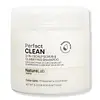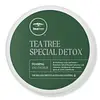NatureLab Tokyo Perfect Clean 2-In-1 Scalp Scrub & Clarifying Shampoo Versus Paul Mitchell Tea Tree Special Detox Foaming Salt Scrub
What's inside
What's inside
 Key Ingredients
Key Ingredients

 Benefits
Benefits

 Concerns
Concerns

 Ingredients Side-by-side
Ingredients Side-by-side

Sucrose
HumectantGlycerin
HumectantSodium C14-16 Olefin Sulfonate
CleansingCocamide Mea
EmulsifyingGlycol Distearate
EmollientWater
Skin ConditioningRicinus Communis Seed Oil
MaskingSaccharomyces/Rice Extract Ferment Filtrate
Skin ConditioningButyrospermum Parkii Butter
Skin ConditioningCocos Nucifera Oil
MaskingMelaleuca Alternifolia Leaf Oil
AntioxidantVitis Vinifera Fruit Extract
Skin ConditioningArgania Spinosa Callus Culture Extract
Skin ConditioningMalus Domestica Fruit Cell Culture Extract
Skin ConditioningGlutamic Acid
HumectantSodium PCA
HumectantHydrolyzed Coix Lacryma-Jobi Ma-Yuen Seed
HumectantPlatinum Powder
AbrasiveTrigonella Foenum-Graecum Hydroxypropyltrimonium Chloride
Skin ConditioningLocust Bean Hydroxypropyltrimonium Chloride
Skin ConditioningSodium Hyaluronate
HumectantHydroxypropyltrimonium Hyaluronate
Prunus Domestica Seed Extract
EmollientArgania Spinosa Kernel Oil
EmollientLupinus Albus Seed Oil
Skin ConditioningMangifera Indica Seed Oil
EmollientTheobroma Grandiflorum Seed Butter
Skin ConditioningAdansonia Digitata Seed Oil
EmollientCarapa Guaianensis Seed Oil
Skin ConditioningSclerocarya Birrea Seed Oil
HumectantArgan Oil Polyglyceryl-6 Esters
EmollientSodium Glycinate
Skin ConditioningPropanediol
SolventCocamidopropyl Betaine
CleansingButylene Glycol
HumectantGuar Hydroxypropyltrimonium Chloride
Skin ConditioningIsomalt
HumectantXanthan Gum
EmulsifyingPolysorbate 80
EmulsifyingCitric Acid
BufferingSodium Citrate
BufferingTrisodium Phosphate
BufferingSodium Chloride
MaskingLecithin
EmollientBHT
AntioxidantSodium Gluconate
Skin ConditioningPhenoxyethanol
PreservativeSodium Benzoate
MaskingParfum
MaskingLinalool
PerfumingSucrose, Glycerin, Sodium C14-16 Olefin Sulfonate, Cocamide Mea, Glycol Distearate, Water, Ricinus Communis Seed Oil, Saccharomyces/Rice Extract Ferment Filtrate, Butyrospermum Parkii Butter, Cocos Nucifera Oil, Melaleuca Alternifolia Leaf Oil, Vitis Vinifera Fruit Extract, Argania Spinosa Callus Culture Extract, Malus Domestica Fruit Cell Culture Extract, Glutamic Acid, Sodium PCA, Hydrolyzed Coix Lacryma-Jobi Ma-Yuen Seed, Platinum Powder, Trigonella Foenum-Graecum Hydroxypropyltrimonium Chloride, Locust Bean Hydroxypropyltrimonium Chloride, Sodium Hyaluronate, Hydroxypropyltrimonium Hyaluronate, Prunus Domestica Seed Extract, Argania Spinosa Kernel Oil, Lupinus Albus Seed Oil, Mangifera Indica Seed Oil, Theobroma Grandiflorum Seed Butter, Adansonia Digitata Seed Oil, Carapa Guaianensis Seed Oil, Sclerocarya Birrea Seed Oil, Argan Oil Polyglyceryl-6 Esters, Sodium Glycinate, Propanediol, Cocamidopropyl Betaine, Butylene Glycol, Guar Hydroxypropyltrimonium Chloride, Isomalt, Xanthan Gum, Polysorbate 80, Citric Acid, Sodium Citrate, Trisodium Phosphate, Sodium Chloride, Lecithin, BHT, Sodium Gluconate, Phenoxyethanol, Sodium Benzoate, Parfum, Linalool
Sodium Chloride
MaskingWater
Skin ConditioningSea Salt
AbrasiveSodium Methyl Cocoyl Taurate
CleansingSodium Cocoyl Isethionate
CleansingCocos Nucifera Oil
MaskingMelaleuca Alternifolia Leaf Oil
AntioxidantRosa Canina Seed Oil
EmollientVolcanic Sand
Skin ConditioningMontmorillonite
AbsorbentQuartz Powder
AbrasiveTocopherol
AntioxidantGlycine Soja Oil
EmollientEthylhexylglycerin
Skin ConditioningAscorbic Acid
AntioxidantPhenoxyethanol
PreservativeSodium Benzoate
MaskingCitric Acid
BufferingParfum
MaskingLinalool
PerfumingCI 61570
Cosmetic ColorantCI 19140
Cosmetic ColorantSodium Chloride, Water, Sea Salt, Sodium Methyl Cocoyl Taurate, Sodium Cocoyl Isethionate, Cocos Nucifera Oil, Melaleuca Alternifolia Leaf Oil, Rosa Canina Seed Oil, Volcanic Sand, Montmorillonite, Quartz Powder, Tocopherol, Glycine Soja Oil, Ethylhexylglycerin, Ascorbic Acid, Phenoxyethanol, Sodium Benzoate, Citric Acid, Parfum, Linalool, CI 61570, CI 19140
Ingredients Explained
These ingredients are found in both products.
Ingredients higher up in an ingredient list are typically present in a larger amount.
Citric Acid is an alpha hydroxy acid (AHA) naturally found in citrus fruits like oranges, lemons, and limes.
Like other AHAs, citric acid can exfoliate skin by breaking down the bonds that hold dead skin cells together. This helps reveal smoother and brighter skin underneath.
However, this exfoliating effect only happens at high concentrations (20%) which can be hard to find in cosmetic products.
Due to this, citric acid is usually included in small amounts as a pH adjuster. This helps keep products slightly more acidic and compatible with skin's natural pH.
In skincare formulas, citric acid can:
While it can provide some skin benefits, research shows lactic acid and glycolic acid are generally more effective and less irritating exfoliants.
Most citric acid used in skincare today is made by fermenting sugars (usually from molasses). This synthetic version is identical to the natural citrus form but easier to stabilize and use in formulations.
Read more about some other popular AHA's here:
Learn more about Citric AcidCocos Nucifera Oil is obtained from the kernels of the coconut fruit. In other words, this is coconut oil.
Coconut Oil is rich in fatty acids with lauric acid making up the majority of these. It also contains linoleic acid. Due to this high fatty acid content, coconut oil helps trap moisture and soften skin.
Despite being antibacterial, coconut oil may not be great for acne-prone skin. It is comedogenic and may clog pores. This ingredient may not be safe for malassezia or fungal acne.
Note: Coconut Oil should not replace your sunscreen for UV protection. Studies show it only blocks about 20% of UV.
This oil is non-volatile and has a light scent.
The term 'fragrance' is not regulated in many countries. In many cases, it is up to the brand to define this term. For instance, many brands choose to label themselves as "fragrance-free" because they are not using synthetic fragrances. However, their products may still contain ingredients such as essential oils that are considered a fragrance.
Learn more about Cocos Nucifera OilLinalool is a fragrance and helps add scent to products. It's derived from common plants such as cinnamon, mint, citrus, and lavender.
Like Limonene, this ingredient oxidizes when exposed to air. Oxidized linalool can cause allergies and skin sensitivity.
This ingredient has a scent that is floral, spicy tropical, and citrus-like.
Learn more about LinaloolThis tea tree oil comes from the leaves of the Tea Tree plant. Tea tree oil has antioxidant, anti-inflammatory, and antimicrobial properties.
According to the book Journal of Profiles of Drug Substances, tea tree helps in reducing acne-causing bacteria such as Propionibacterium acnes. This is due to the Terpinen components of tea tree oil.
Tea tree may cause sensitivity and irritation for some people. This oil naturally contains fragrance such as linalool and limonene.
However, research shows irritation usually occurs when using pure tea tree oil and not in cosmetic products.
Tea tree oil was found to help relieve the symptoms of psoriasis in one study.
Tea tree oil is toxic when ingested. Another study showed it to caused damage to the nervous system of dogs and cats when applied to their skin or given orally.
Learn more about Melaleuca Alternifolia Leaf OilParfum is a catch-all term for an ingredient or more that is used to give a scent to products.
Also called "fragrance", this ingredient can be a blend of hundreds of chemicals or plant oils. This means every product with "fragrance" or "parfum" in the ingredients list is a different mixture.
For instance, Habanolide is a proprietary trade name for a specific aroma chemical. When used as a fragrance ingredient in cosmetics, most aroma chemicals fall under the broad labeling category of “FRAGRANCE” or “PARFUM” according to EU and US regulations.
The term 'parfum' or 'fragrance' is not regulated in many countries. In many cases, it is up to the brand to define this term.
For instance, many brands choose to label themselves as "fragrance-free" because they are not using synthetic fragrances. However, their products may still contain ingredients such as essential oils that are considered a fragrance by INCI standards.
One example is Calendula flower extract. Calendula is an essential oil that still imparts a scent or 'fragrance'.
Depending on the blend, the ingredients in the mixture can cause allergies and sensitivities on the skin. Some ingredients that are known EU allergens include linalool and citronellol.
Parfum can also be used to mask or cover an unpleasant scent.
The bottom line is: not all fragrances/parfum/ingredients are created equally. If you are worried about fragrances, we recommend taking a closer look at an ingredient. And of course, we always recommend speaking with a professional.
Learn more about ParfumPhenoxyethanol is a preservative that has germicide, antimicrobial, and aromatic properties. Studies show that phenoxyethanol can prevent microbial growth. By itself, it has a scent that is similar to that of a rose.
It's often used in formulations along with Caprylyl Glycol to preserve the shelf life of products.
Sodium Benzoate is a preservative. It's used in both cosmetic and food products to inhibit the growth of mold and bacteria. It is typically produced synthetically.
Both the US FDA and EU Health Committee have approved the use of sodium benzoate. In the US, levels of 0.1% (of the total product) are allowed.
Sodium benzoate works as a preservative by inhibiting the growth of bacteria inside of cells. It prevents the cell from fermenting a type of sugar using an enzyme called phosphofructokinase.
It is the salt of benzoic acid. Foods containing sodium benzoate include soda, salad dressings, condiments, fruit juices, wines, and snack foods.
Studies for using ascorbic acid and sodium benzoate in cosmetics are lacking, especially in skincare routines with multiple steps.
We always recommend speaking with a professional, such as a dermatologist, if you have any concerns.
Learn more about Sodium BenzoateChances are, you eat sodium chloride every day. Sodium Chloride is also known as table salt.
This ingredient has many purposes in skincare: thickener, emulsifier, and exfoliator.
You'll most likely find this ingredient in cleansers where it is used to create a gel-like texture. As an emulsifier, it also prevents ingredients from separating.
There is much debate on whether this ingredient is comedogenic. The short answer - comedogenic ratings don't tell the whole story. Learn more about comegodenic ratings here.
The concensus about this ingredient causing acne seems to be divided. Research is needed to understand if this ingredient does cause acne.
Scrubs may use salt as the primary exfoliating ingredient.
Learn more about Sodium ChlorideWater. It's the most common cosmetic ingredient of all. You'll usually see it at the top of ingredient lists, meaning that it makes up the largest part of the product.
So why is it so popular? Water most often acts as a solvent - this means that it helps dissolve other ingredients into the formulation.
You'll also recognize water as that liquid we all need to stay alive. If you see this, drink a glass of water. Stay hydrated!
Learn more about Water